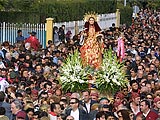 These
festivals begin with a pilgrimage in which the image
of 'Santa Eulalia' is taken from the retreat
in the mountain to that of 'San Roque'. Later,
the image is taken to the church of 'Santiago'
(Saint James), when a procession also takes place.
These
festivals begin with a pilgrimage in which the image
of 'Santa Eulalia' is taken from the retreat
in the mountain to that of 'San Roque'. Later,
the image is taken to the church of 'Santiago'
(Saint James), when a procession also takes place.This pilgrimage dates back to the seventeenth century when people from Totana and other places, attracted by news of the many miracles performed by the Saint, began to go along to the mountain retreat. As the place itself was gloomy and it was a cold time of year, the people sheltered inside the retreat, where stewards brought them food and drink, and they spent the night singing and dancing.
Now, as in the past, on the night before, people
from Totana and the surrounding area, who hold a
special affection for both the mountain and the
Saint, arrange to meet at the foot of the mountain
to spend the night in good company and to enjoy
'migas' (a typical hearty dish of fried
breadcrumbs) and good wine whilst they wait for
daybreak. The image is taken out of the retreat
by bearers, who carry it on their shoulders, in
the early hours of the morning. Barefoot devotees
and merry pilgrims show their devotion to the Saint
by accompanying her on her journey with euphoric
religious chants, which can only be heard at times
like this.
The journey of the Saint through 'Los Huertos'
is charming and emotive, especially when the followers
draw near to the image and cheer her in passing,
whilst those who carry the Saint give out sweets
to the people who have spent a long night outdoors.
The pilgrimage continues in this fashion until it
arrives at a place, which has long since been known
as 'El Rulo', where the image is received
by the townspeople and the civil and ecclesiastical
dignitaries alike, who then accompany their patron
to the end of her pilgrimage, which is found at
the retreat of 'San Roque'.
